Your Search Results
-
Promoted Content
-
Promoted Content
-
 Trusted Partner
The ArtsOctober 2015
Trusted Partner
The ArtsOctober 2015Film light
Meaning and emotion
by Lara Thompson
In one of the first monographs of its kind to focus on the aesthetic and emotional impact of lighting in cinema, Lara Thompson looks at the way light informs the cinematic experience, from constructing star identities, sculpting natural light and creating imaginary worlds, to the seductive power of darkness, fading representations of the past and arresting twilight encounters. This groundbreaking and accessible introductory study offers a unique insight into the way illumination has transcended its diffuse functional boundaries and been elevated to a position of narrative and emotional importance, transforming it from an unobtrusive element of film style to an expressive and essential component. It includes analyses of over fifty renowned international films, discussed in inventive and illuminating combinations, from cinema's earliest moments to its most recent digital manifestations, and is essential reading for all those who want to understand what film light means and how it makes us feel. ;
-
 Trusted Partner
Humanities & Social SciencesMarch 2026
Trusted Partner
Humanities & Social SciencesMarch 2026Black socialities
Urban resistance and the struggle beyond recognition in Paris
by Vanessa Eileen Thompson
From author: This is a cutting-edge exploration of black urban politics in Parisian racialized working class and working poor districts, the formation of abolition geography, and the possibilities of new forms of political blackness. In Black Socialities. Urban resistance and the struggle beyond recognition in Paris, Vanessa E. Thompson argues that black urban politics in the French banlieues are multi-racial and spatially grounded towards abolition. Based on a close engagement with urban black activist practices against racial imagery in the city, policing and state racism, and housing insecurity, she shows how radical anti-racism goes beyond struggles for recognition and unfolds alongside new formations of political blackness that is based on urban conviviality. This form of black politics has much to teach us in this current conjuncture of liberal anti-racism and state recognition politics.
-
 Trusted Partner
The ArtsFebruary 2006
Trusted Partner
The ArtsFebruary 2006Digging up stories
Applied theatre, performance and war
by James Thompson, Martin Hargreaves
In 'Digging up stories', James Thompson explores the problems of theatre practice in communities affected by war and exclusion. Each chapter or 'story' is written in a lively and accessible style and draws on a range of contemporary performance theories. The chapters discuss: - participatory theatre in refugee camps - theatre workshop and stories of a massacre - traditional dance-dramas in an insurgent controlled village - 'Forum' theatre with the Mahabharata - ethical issues - the struggle to teach the author to dance 'Digging up stories' documents a range of theatre practice and includes project reports, ethnographic accounts, performance analysis and diary-style reflection. Taken from Thompson's research and practice in Sri Lanka, these diverse examples question the link between applied theatre, traditional performance and performances in everyday life. The book blurs lines between research and travel writing to create rich and provocative accounts of applying theatre in a troubled setting. ;
-
 Trusted Partner
January 1983
Trusted Partner
January 1983Über Wachstum und Form
In gekürzter Fassung neu herausgegeben von John Tyler Bonner. Übersetzt von Ella M. Fountain und Magdalena Neff. Mit einem Geleitwort von Adolf Portmann
by D'Arcy Wentworth Thompson, John Tyler Bonner, Ella M. Fountain, Adolf Portmann
Zweifellos ist es ein verlegerisches Wagnis, DʼArcy Thompsons legendäres Buch im Zeitalter des Quasi-Ausschließlichkeitsanspruchs von Biochemie und Molekularbiologie in einer Neuauflage und dazu in deutscher Sprache herauszubringen. Wer von den jungen Biologen verbindet heute noch mit Thompsons Namen einen Begriff? Wer war dieser Mann? Was macht sein Werk noch heute druckenswert? Man könnte vielleicht aphoristisch sagen: DʼArcy Thompson war einer jener Polyhistores, von denen man meinte, sie seien mit dem Verklingen des Barock ausgestorben und in späterer Zeit nicht einmal mehr denkbar. Mithin ein verspäteter Barock-Gelehrter? Keineswegs, sondern einer der Pioniere der modernsten Biologie! Er vereinigte in sich das Denkvermögen des Mathematikers und Physikers mit dem des Linguisten und des Biologen, und er verfügt über das Handwerkliche aller drei dieser – ach doch so verschiedenen – Wissensgebiete. Dieses Buch hat eine widersprüchliche Geschichte: 1917 erschien die erste Auflage – damals vollendete Ketzerei – mit 793 Seiten Umfang, 1942 eine Erweiterung auf 1116 Seiten. Die posthume Neuauflage von Bonner – sie liegt der Übersetzung zugrunde – knüpft an die erste Auflage an, läßt vieles aus (weil es nicht mehr aktuell ist) und bringt zahlreiche Kommentare des Herausgebers. Es handelt sich also bei der vorliegenden Ausgabe um eine »Klassikeredition in Auswahl und mit Kommentar versehen«. Dies ist bei einem Buch mit einer erst 55jährigen Geschichte bemerkenswert. Um es vorwegzunehmen: von Thompsons Konzeption ist nichts Wesentliches verlorengegangen, und die Kommentare machen die Orientierung für denjenigen, der die Literatur nicht selbst kennt, leichter. (So. J.H. Scharf, Halle, 1974 in seiner Besprechung der deutschen Erstausgabe.)
-
 Trusted Partner
September 2021
Trusted Partner
September 2021Weihnachten auf Thompson Hall
by Anthony Trollope, Irmela Schautz, Andrea Ott
Brown am Abend vor Weihnachten in einem Pariser Hotel mit Husten krank im Bett liegt, kommt ihm das nicht ganz ungelegen: Seine Frau wollte dieses Jahr unbedingt im Kreise der Großfamilie auf dem englischen Familiensitz feiern, doch er hat ganz und gar keine Lust, am kommenden Tag früh dorthin aufzubrechen. Mrs. Brown will keine Ausflüchte gelten lassen, und damit ihr Mann rasch wieder zu Kräften kommt, verspricht sie ihm einen Senfwickel, der seinen Husten mildern soll. Doch woher mitten in der Nacht in einem fremden Hotel Senf nehmen? Mrs. Brown irrt durch die dunklen Gänge, doch als es ihr endlich gelingt, den Senfwickel anzulegen, erlebt sie eine Überraschung … Eine herrlich vergnügliche Weihnachtsgeschichte der etwas anderen Art mit bestem britischen Humor von Anthony Trollope.
-
 Trusted Partner
Humanities & Social SciencesJune 2015
Trusted Partner
Humanities & Social SciencesJune 2015E. P. Thompson and English radicalism
by Edited by Roger Fieldhouse and Richard Taylor
-
 Trusted Partner
Trusted Partner
-
 Trusted Partner
Trusted Partner
-
 Trusted Partner
Trusted Partner
-
 Trusted Partner
Trusted Partner
-
 Trusted Partner
Trusted Partner
-
 Trusted Partner
March 2023
Trusted Partner
March 2023Die Bibliothek der Hoffnung
Roman
by Thompson, Kate
Aus dem Englischen von Anja Schünemann
-
 Trusted Partner
December 2008
Trusted Partner
December 2008Dreißig Gespräche
by Max Dax
Max Dax, seit 2006 Chefredakteur des Musikmagazins Spex, gab zuvor die Interviewzeitschrift Alert heraus. Dabei entstanden gesprochene (Selbst-)Porträts von (Techno-)Musikern, Künstlern, Regisseuren und Schriftstellern und ganz nebenbei eine Zwischenbilanz der Gegenwartskultur. Zu Wort kommen in dieser Auswahl: Aphex Twin, Blixa Bargeld, David Bowie, Vashti Bunyan, Diedrich Diederichsen, DJ Hell, Kim Gordon, Juliette Gréco, Charlie Haden, Herbie Hancock, Lee Hazelwood, Jenny Holzer, Dennis Hopper, Jörg Immendorff, Lemmy Kilmister, Martin Kippenberger, Alexander Kluge, Claude Lanzmann, Arto Lindsay, Marcel Marceau, Johnny Marr, Thomas Ruff, Helge Schneider, Mark E. Smith, Bernhard Sumner, Mayo Thompson, Caetano Veloso, Roger Waters und Townes van Zandt.
-
 Trusted Partner
Trusted Partner
-
 Trusted Partner
Trusted Partner
-
 Trusted Partner
Trusted Partner
-
 Trusted Partner
August 2004
Trusted Partner
August 2004King Arthur
Das Buch zum Film nach dem Drehbuch von David Franzoni
by Thompson, Frank / Deutsch Peters, Joachim
-
 Trusted Partner
Humanities & Social SciencesNovember 2009
Trusted Partner
Humanities & Social SciencesNovember 2009Ireland, India and empire
by Kate O'Malley, Andrew Thompson, John Mackenzie






























